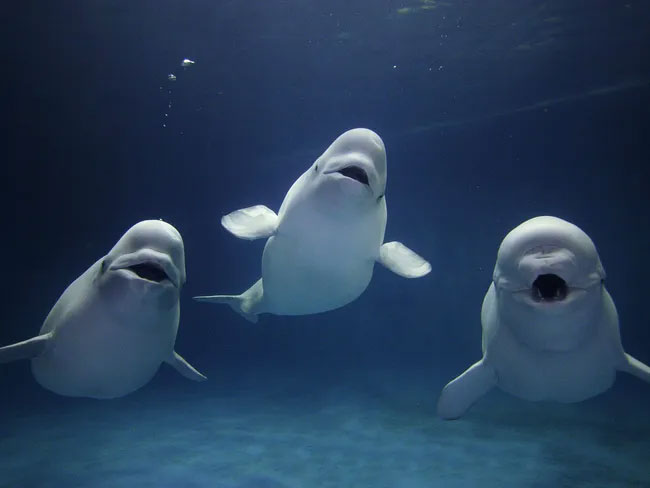Beluga whales are among the smartest animals in the ocean.
The Beluga whale, also known as the white whale, is one of the smallest whale species in the animal kingdom. They possess a distinctive smooth white skin and a classic “forehead” that gives them an unmistakable appearance.
Beluga whales typically live in pods; they have a highly organized social structure and a variety of communication methods, including whistles.
They inhabit the waters of the Arctic Ocean or sub-Arctic regions, with some found in deeper coastal waters. Beluga whales feed on smaller marine animals and hunt similarly to orcas. However, they are incredibly friendly and affectionate towards humans.
Adult Beluga whales can grow up to 4 meters long and have brains that are twice the size of a human’s, even possessing more folds. They demonstrate problem-solving skills, communication abilities, and can remain calm in stressful situations, making them easy to train.
Thanks to their ability to mimic various sounds and even “sing,” Beluga whales are often referred to as the “canaries of the sea.”

They live in pods and often enjoy singing.
However, this is where it gets interesting. In 2017, Newsweek reported that a Beluga whale had “learned” the “language” of dolphins after moving in with a pod of dolphins. Previously, this Beluga whale had lived with its own kind and “spoke” the typical Beluga sounds.
After two months of “moving,” it began producing new whistles with tones similar to those of its dolphin companions. It even managed to create distinctive whistles indistinguishable from those of regular dolphins to blend in easily.
This is not too surprising, as Beluga whales and bottlenose dolphins are closely related.
The bizarre phenomenon and its real explanation
What truly sends chills down the spine is the story of a captive Beluga whale named NOC.
NOC was held at a marine mammal facility in San Diego, California, until its death in 1999. In 1984, scientists discovered a bizarre phenomenon when human speech was heard around NOC’s enclosure despite there being no one present.
The co-author of the study at the time acknowledged the presence of human-like sounds, but it was difficult to discern what the sounds were trying to communicate.
Of course, scientists did not seek supernatural explanations for these phenomena. The situation became even more intriguing when a diver in the whale tank reported hearing a voice saying “out,” as if someone was trying to get them to leave.
It turned out that the voice was coming from NOC. In fact, this whale had many opportunities to listen to human conversations, both from people outside the tank and divers communicating with each other.
In a more rigorous test to see if NOC could truly mimic human speech, scientists rewarded it with treats when it produced those sounds, encouraging it to do so long enough for them to record.

Beluga whales are very friendly and affectionate towards humans, despite being carnivorous.
Analysis of NOC’s sounds revealed a rhythm similar to human speech. They also displayed fundamental frequencies lower by several octaves compared to typical whale sounds and were much closer to human vocalizations.
Researcher Sam Ridgway, a neurobiologist, veterinarian, and president of the National Marine Mammal Foundation, told LiveScience: “We were amazed – we were really surprised – that sound truly reminded us of human speech and was unlike typical whale sounds. We had never heard anything like this before.”
In addition to NOC, many also recount the story of another Beluga whale in Vancouver, Canada, which could articulate its name, “Lagosi.”

















































